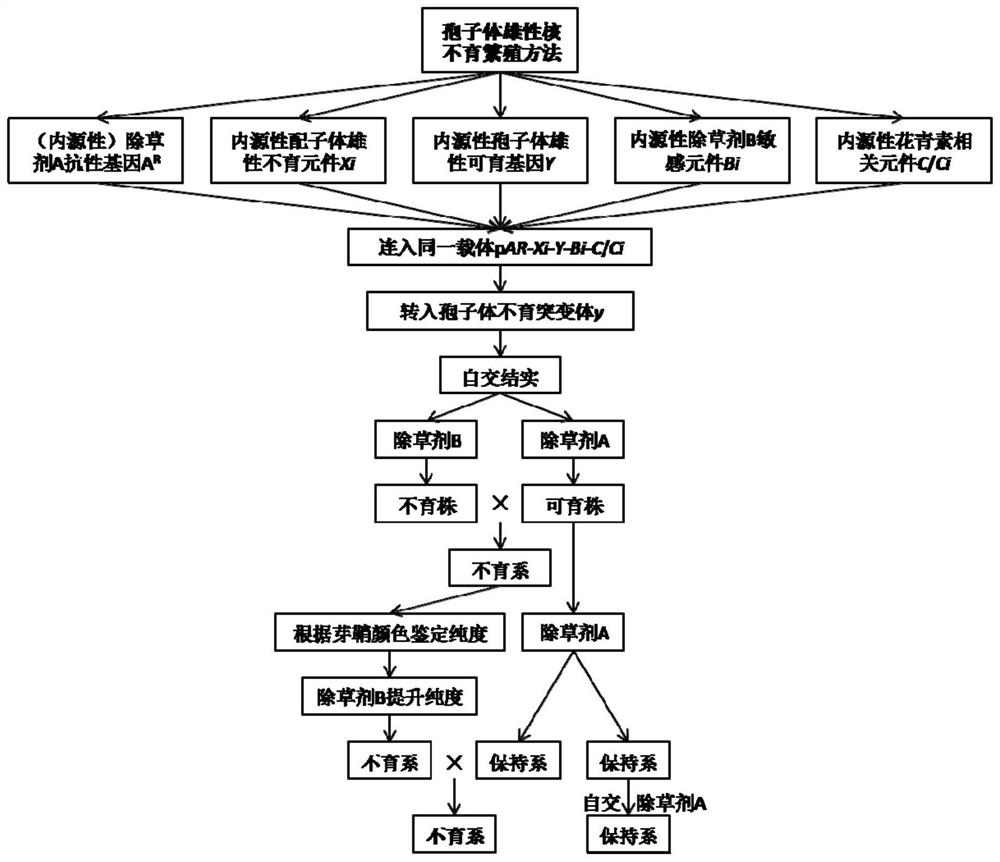A method for reproducing sporophyte recessive male sterility
A technology for reproducing spores and male nuclei, applied in the field of genetic engineering, can solve problems such as the production of difficult hybrids, and achieve the effect of reducing concerns about transgenics and reducing losses
- Summary
- Abstract
- Description
- Claims
- Application Information
AI Technical Summary
Problems solved by technology
Method used
Image
Examples
Embodiment 1
[0023] Embodiment 1, vector construction process
[0024] 1) OsMYB76R gene loaded into pCAMBIA1301
[0025] According to previous studies, the OsMYB76 gene is an essential gene for anthocyanin synthesis in rice. In rice ZhongjiuB and other materials, due to the loss-of-function mutation of the OsMYB76 gene, all organs do not show anthocyanin color (Zhang Yi, 2009). After optimizing the OsMYB76 gene and removing the commonly used enzyme cutting sites, the OsMYB76R gene (SEQ ID NO.11) was artificially synthesized. Using OsMYB76R as a template, the primers JCF1 (SEQ ID NO.12) / JCR2 (SEQ ID NO.13) were used The target fragment was amplified and recovered for use. The GUS gene in pCAMBIA1301 was completely excised with NcoI and BstEII, and the backbone was recovered for use; OsMYB76R was loaded into pCAMBIA1301 by homologous recombination to obtain vector 1301-JC.
[0026] 2) Modification of 1301-JC multiple cloning sites
[0027] In order to facilitate the loading of various regu...
Embodiment 2
[0036] Embodiment 2, the method for propagating sporophyte recessive male sterility
[0037] 1. Breeding of nine B-osabcg15 in sporophyte sterile material
[0038] A male sterile mutant (Wu et al., 2014) naturally produced by the OsABCG15 gene was used as a sterile donor, Zhongjiu B was used as a recurrent parent, and Zhongjiu B-osabcg15 was produced through multiple backcrosses.
[0039] 2. pA R -Xi-Y-Bi-C transferred to S9 B-osabcg15
[0040] In the fertility-separated population, select sterile Zhongjiu B-osabcg15 plants, take their young ears to induce callus, and use the method of Agrobacterium tumefaciens to introduce the final vector pA R -Xi-Y-Bi-C transfects the aforementioned callus, differentiates into seedlings, and after rooting and transplanting, 8 strains showing anthocyanin color are selected as positive strains, all of which show male fertility ( figure 2 ).
[0041] 3. Propagation and purity control of B-osabcg15 in sporophytic male sterility
[0042] 1...
PUM
| Property | Measurement | Unit |
|---|---|---|
| purity | aaaaa | aaaaa |
Abstract
Description
Claims
Application Information
 Login to View More
Login to View More - R&D
- Intellectual Property
- Life Sciences
- Materials
- Tech Scout
- Unparalleled Data Quality
- Higher Quality Content
- 60% Fewer Hallucinations
Browse by: Latest US Patents, China's latest patents, Technical Efficacy Thesaurus, Application Domain, Technology Topic, Popular Technical Reports.
© 2025 PatSnap. All rights reserved.Legal|Privacy policy|Modern Slavery Act Transparency Statement|Sitemap|About US| Contact US: help@patsnap.com


